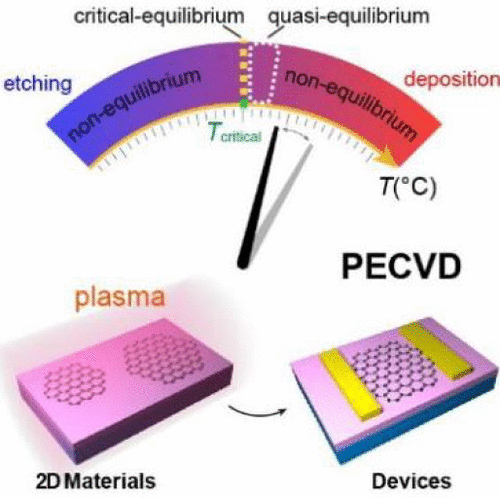当前位置:
X-MOL 学术
›
Acc. Chem. Res.
›
论文详情
Our official English website, www.x-mol.net, welcomes your
feedback! (Note: you will need to create a separate account there.)
Plasma-Enhanced Chemical Vapor Deposition of Two-Dimensional Materials for Applications
Accounts of Chemical Research ( IF 16.4 ) Pub Date : 2021-02-03 , DOI: 10.1021/acs.accounts.0c00757 Kongyang Yi 1, 2, 3 , Donghua Liu 1, 2 , Xiaosong Chen 1, 2 , Jun Yang 4 , Dapeng Wei 4 , Yunqi Liu 2, 5 , Dacheng Wei 1, 2
Accounts of Chemical Research ( IF 16.4 ) Pub Date : 2021-02-03 , DOI: 10.1021/acs.accounts.0c00757 Kongyang Yi 1, 2, 3 , Donghua Liu 1, 2 , Xiaosong Chen 1, 2 , Jun Yang 4 , Dapeng Wei 4 , Yunqi Liu 2, 5 , Dacheng Wei 1, 2
Affiliation

|
Since the rise of two-dimensional (2D) materials, synthetic methods including mechanical exfoliation, solution synthesis, and chemical vapor deposition (CVD) have been developed. Mechanical exfoliation prepares randomly shaped materials with small size. Solution synthesis introduces impurities that degrade the performances. CVD is the most successful one for low-cost scalable preparation. However, when it comes to practical applications, disadvantages such as high operating temperature (∼1000 °C), probable usage of metal catalysts, contamination, defects, and interstices introduced by postgrowth transfer are not negligible. These are the reasons why plasma-enhanced CVD (PECVD), a method that enables catalyst-free in situ preparation at low temperature, is imperatively desirable.
中文翻译:

用于二维材料的等离子体增强化学气相沉积
由于二维(2D)材料的兴起,已经开发了包括机械剥离,溶液合成和化学气相沉积(CVD)在内的合成方法。机械剥离可制备出尺寸较小的随机形状的材料。溶液合成会引入会降低性能的杂质。CVD是低成本可扩展制备最成功的方法。但是,在实际应用中,诸如高工作温度(约1000°C),可能使用金属催化剂,污染,缺陷和由生长后转移引入的空隙等缺点是不可忽略的。这些是迫切需要等离子体增强CVD(PECVD)的原因,该方法能够在低温下实现无催化剂的原位制备。
更新日期:2021-02-16
中文翻译:

用于二维材料的等离子体增强化学气相沉积
由于二维(2D)材料的兴起,已经开发了包括机械剥离,溶液合成和化学气相沉积(CVD)在内的合成方法。机械剥离可制备出尺寸较小的随机形状的材料。溶液合成会引入会降低性能的杂质。CVD是低成本可扩展制备最成功的方法。但是,在实际应用中,诸如高工作温度(约1000°C),可能使用金属催化剂,污染,缺陷和由生长后转移引入的空隙等缺点是不可忽略的。这些是迫切需要等离子体增强CVD(PECVD)的原因,该方法能够在低温下实现无催化剂的原位制备。











































 京公网安备 11010802027423号
京公网安备 11010802027423号